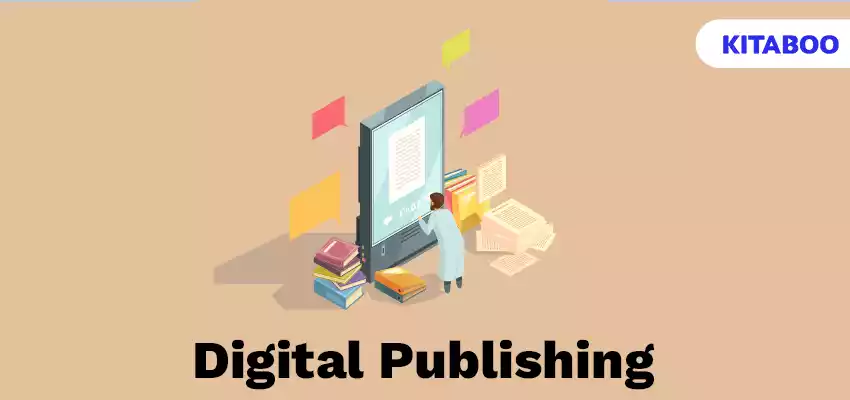
Navigating the Future: Digital Publishing’s Global Market Impact
In today’s ever-evolving world of digital publishing, one of the best ways to stand out from the competition is to stay abreast of industry trends.
Expected to grow from $46.48 billion in 2023 to a whopping $51.78 billion in 2024, the growth observed in this industry can be attributed to a range of factors, including the expansion of internet accessibility, the proliferation of mobile devices, the e-book revolution, the implementation of digital rights management (DRM), and the rapid shift to online content consumption.
Further, leveraging cloud-based digital publishing platforms such as KITABOO can help you keep pace with the key trends and initiatives of the global digital publishing market.
This post aims to deep dive into the online publishing market while outlining the overall global market impact of digital publishing.
Table of Contents
I. How Digital Publishing Is Impacting Global Market
- Availability and Distribution
- Multimedia Integration
- Publication Speed
- Easy Adaptation and Personalization
- Copyright and Piracy Concerns
- Enhanced Accessibility of Content
II. To Sum It Up
How Digital Publishing Is Impacting Global Market
With the growing popularity of digital publishing, driven by a range of assorted factors in both the academic and corporate sectors, it would be interesting to see what the future holds for this space.
Here we will discuss some of the key ways digital publishing is impacting the overall global market-
1. Availability and Distribution
Digital publishing today has made content easily accessible to a larger global audience. It allows readers to instantly download or access books, articles, and other content from anywhere in the world. This has enabled content creators and publishers to reach a broader audience much faster.
Further, easy distribution is another big advantage of digital publishing. Online content can be easily made available on all popular online marketplaces, including the Amazon Kindle Store, Google Play Books, Apple Books, and more. These platforms offer a wide reach and an established customer base for both authors and publishers.
2. Multimedia Integration
Multimedia integration in digital publishing is the process of incorporating different multimedia elements, such as audio, videos, gifs, animations, images, interactive graphics, and more, into your digital content. This, in turn, enhances the reader’s experience and offers a more engaging and interactive way of presenting information.
There are several other advantages to integrating multimedia into digital publishing. Among these include:
- Improved content comprehension
- Enhanced reader engagement
- An immersive and interactive reading experience
With rapid advancement in technology, multimedia integration in the future is likely to play an increasingly significant role in how content is presented and consumed by readers in the digital landscape.
3. Publication Speed
Digital publishing plays a significant role in the speed of publication. Unlike traditional print publishing, where the overall process of producing physical copies can be quite taxing in terms of time needed, digital publishing offers faster and more efficient ways to make content available to readers.
In digital publishing mode, you can publish your content quickly, thus reducing the time between writing and making it available to the audience. This is especially relevant for educational and corporate training content, where accurate and timely dissemination of information plays an important role.
Also Read: Revolutionizing Reading: The Global Impact on Digital Publishing
4. Easy Adaptation and Personalization
Digital publishing makes it easy to adapt and personalize content as per individual preferences, needs, and behaviours for an improved reading experience.
One of the key benefits of this mode of publishing is that it allows for dynamic updates and quick revisions to content. This means that publishers can easily respond to reader feedback and changing trends, thus ensuring that content remains relevant and up-to-date. In addition to this, digital publishing platforms can employ different algorithms to tailor content recommendations for specific sets of readers.
5. Copyright and Piracy Concerns
Copyright and piracy are some of the most significant concerns in the field of digital publishing. This is primarily because the ease of copying and distributing digital content has given rise to a range of challenges for content creators, publishers, and end users.
To navigate the challenge effectively, authors and publishers need to implement effective digital rights management (DRM) systems. DRM is a powerful technology that helps you protect and safeguard your content.
Some of these challenges and concerns are discussed in more detail below:
- Plagiarism: Digital publishing makes it much simpler for individuals to copy or plagiarize content and republish it without giving proper credit. This compromises the author’s intellectual property rights and damages their reputation in the long run as well.
- Unauthorized distribution of content: Another issue with digital publishing is that the content in this mode can be easily copied and shared, leading to the unauthorized distribution of copyrighted material. This leads to both lost opportunities and revenue for content creators and publishers.
- Loss of control over content: Copyright piracy concerns take away the control that content creators, authors, and publishers have over the distribution and presentation of their content. This kind of illegitimate copy of the digital content might be changed or altered, leading to a wrong or distorted representation of the original work.
When it comes to addressing these copyright and piracy concerns, what is really needed is a multi-faceted approach that involves an appropriate combination of tech solutions, legal remedies, and other adaptive business strategies.
6. Enhanced Accessibility of Content
Another area where digital publishing is going to make a global impact is in improving the accessibility of content and making it more inclusive for a diverse audience.
An increasing number of digital learning platforms today feature an array of key enhancements that enable all types of readers and learners to access the content. Among these include screen reading, text-to-speech feature, adaptive reading, font and color adjustments, and more.
These are the aspects that allow readers to tweak their digital content according to their individual preferences.
Also Read: Digital Content Evolution: Impacting Global Publishing Trends
To Sum It Up
Digital publishing is an ever-evolving space that has completely transformed the process of content creation, publication, and distribution. The future will see top digital publishing platforms such as KITABOO leading the space by offering a range of useful features that have revolutionized the industry.
KITABOO makes distributing your digital content quite cost-effective while also allowing readers to read online on multiple different devices conveniently. Another highlight of KITABOO is its DRM protection technology, which ensures the security of your digital content.
If you are looking for a one-stop comprehensive platform for crafting, editing, publishing, and managing digital content as K-12 publishers, ed-tech companies, or educational institutions, KITABOO offers everything you need.
Connect with us now to learn more about KITABOO.
Discover how a mobile-first training platform can help your organization.
Kitaboo is a cloud-based platform to create, deliver & track mobile-first interactive training content.






